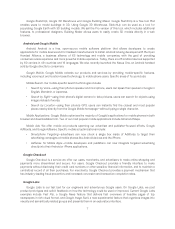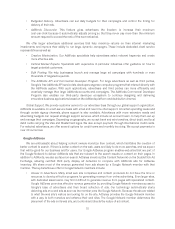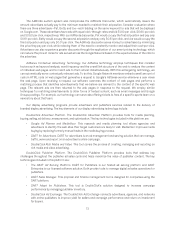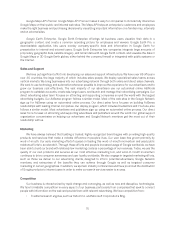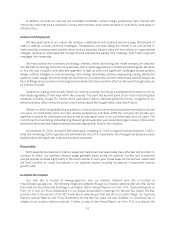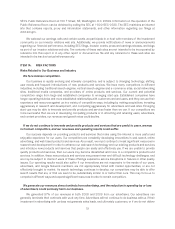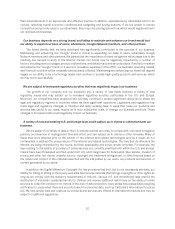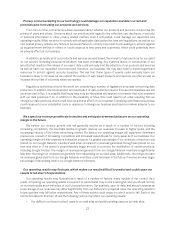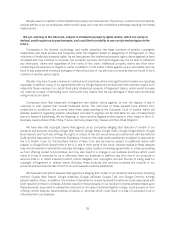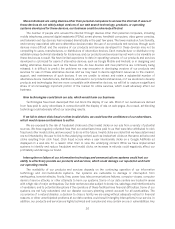Google 2009 Annual Report Download - page 34
Download and view the complete annual report
Please find page 34 of the 2009 Google annual report below. You can navigate through the pages in the report by either clicking on the pages listed below, or by using the keyword search tool below to find specific information within the annual report.• Vertical search engines and e-commerce sites, such as WebMD (for health queries), Kayak (travel
queries), Monster.com (job queries), and Amazon.com and eBay (commerce). We compete with these
sites because they, like us, are trying to attract users to their web sites to search for product or service
information, and some users will navigate directly to those sites rather than go through Google.
• Social networks, such as Facebook, Yelp, or Twitter. Some users are relying more on social networks for
product or service referrals, rather than seeking information through traditional search engines.
• Other forms of advertising. We compete against traditional forms of advertising—such as television, radio,
newspapers, magazines, billboards, and yellow pages—for ad dollars.
• Mobile applications. As the mobile application ecosystem develops further, users are increasingly
accessing e-commerce and other sites through those companies’ stand-alone mobile applications,
instead of through search engines.
• Providers of online products and services. We also provide a number of online products and services,
including Gmail, YouTube, and Google Docs, that compete directly with new and established companies
that offer communication, information, and entertainment services integrated into their products or
media properties.
We compete to attract and retain users of our search and communication products and services. Most of the
products and services we offer to users are free, so we do not compete on price. Instead, we compete in this area
on the basis of the relevance and usefulness of our search results and the features, availability, and ease of use of
our products and services.
Neither our users nor our advertisers are locked in to Google. For users, other search engines are literally one
click away, and there are no costs to switching search engines. Our advertisers typically advertise in multiple
places, both online and offline. We compete to attract and retain content providers (Google Network members, as
well as other content providers for whom we distribute or license content) primarily based on the size and quality of
our advertiser base, our ability to help these partners generate revenues from advertising, and the terms of the
agreements.
Intellectual Property
We rely on a combination of patent, trademark, copyright, and trade secret laws in the U.S. and other
jurisdictions as well as confidentiality procedures and contractual provisions to protect our proprietary technology
and our brand. We also enter into confidentiality and invention assignment agreements with our employees and
consultants and confidentiality agreements with other third parties, and we rigorously control access to proprietary
technology.
Google, YouTube, DoubleClick, DART, AdSense, AdWords, Gmail, I’m Feeling Lucky, PageRank, Blogger,
orkut, Picasa, SketchUp, and Postini are registered trademarks in the U.S. Our unregistered trademarks include,
Blog*Spot, Jaiku, Android, Open Handset Alliance, OpenSocial, Panoramio, and Knol.
The first version of the PageRank technology was created while Larry and Sergey attended Stanford
University, which owns a patent to PageRank. The PageRank patent expires in 2017. We hold a perpetual license to
this patent. In October 2003, we extended our exclusivity period to this patent through 2011, at which point our
license will become non-exclusive.
Circumstances outside our control could pose a threat to our intellectual property rights. For example,
effective intellectual property protection may not be available in every country in which our products and services
are distributed. Also, the efforts we have taken to protect our proprietary rights may not be sufficient or effective.
Any significant impairment of our intellectual property rights could harm our business or our ability to compete.
Also, protecting our intellectual property rights is costly and time consuming. Any increase in the unauthorized use
of our intellectual property could make it more expensive to do business and harm our operating results.
16



